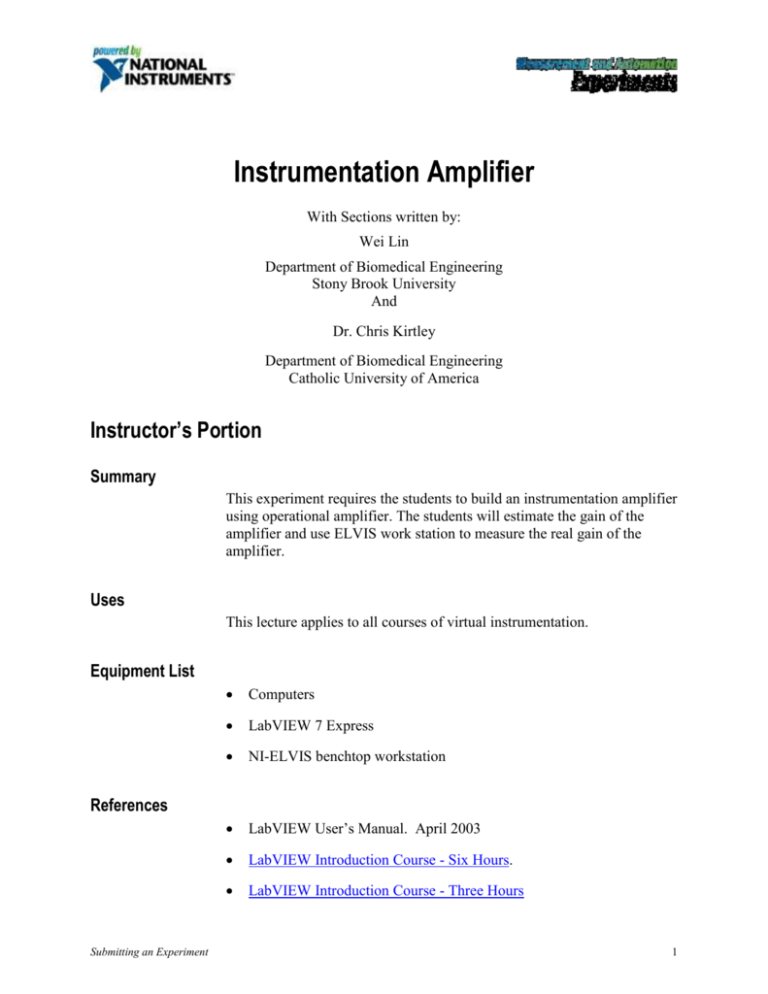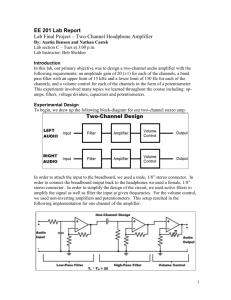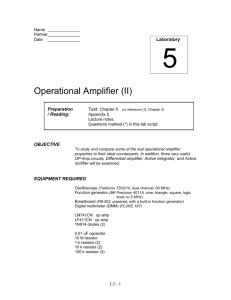Instrumentation Amplifier
advertisement

Instrumentation Amplifier With Sections written by: Wei Lin Department of Biomedical Engineering Stony Brook University And Dr. Chris Kirtley Department of Biomedical Engineering Catholic University of America Instructor’s Portion Summary This experiment requires the students to build an instrumentation amplifier using operational amplifier. The students will estimate the gain of the amplifier and use ELVIS work station to measure the real gain of the amplifier. Uses This lecture applies to all courses of virtual instrumentation. Equipment List Computers LabVIEW 7 Express NI-ELVIS benchtop workstation LabVIEW User’s Manual. April 2003 LabVIEW Introduction Course - Six Hours. LabVIEW Introduction Course - Three Hours References Submitting an Experiment 1 Lecture Slides of “Data Analysis Using LabVIEW” VIs from the project “Data Acquisition Using NI-DAQmx” Student’s Portion Introduction The students will build the instrumentation amplifier based on the provided schematics diagram (see appendix). They will use the rules of ideal operational amplifier to estimate the gain of the built instrumentation amplifier. They are also required to develop a protocol to measure the gain using the signal generator in ELVIS workstation and the data acquisition VI developed in the previous project titled “Data Acquisition Using NI-DAQmx VIs”. Objectives Design an Instrumentation amplifier with gain of 1000 Data acquisition using LabVIEW Theory The instrumentation amplifier is the popular preamplifier for signal conditioning. It offers high impedance and common mood rejection ratio (CMRR). It composes of three amplifiers. The gain of the amplifier is determined by the resistor network based on the rules of ideal operational amplifier. Submitting an Experiment 2 Limitations of the simple RC-Filter/Op-amp Circuit Although this simple circuit worked (in most cases!), I think you'll agree that the quality of the ECG was pretty poor. Hopefully, you noticed the following problems: There was still too much noise from AC hum o Although the QRS complex could just be seen, the P and T wave were swamped by noise o Heavier smoothing (by reducing the filter cutoff) reduced the noise, but also reduced the ECG signal There was also a problem of drift o There was often a DC offset on the signal due to static charge on the subject o There was a low frequency drift ("baseline wander") whenever the subject or electrodes moved (motion artifact) o It made it difficult to keep the signal on the oscilloscope screen o It could even saturate the amplifier by making the output rise or fall to the supply rail voltage The Differential Amplifier In order to improve the signal further, we need a new design for our amplifier: Submitting an Experiment 3 This new design is called a differential amplifier, because it amplifies the difference between the two input voltages. The gain is given by Gain R2 (Vin Vin ) R1 Common mode rejection Since the output is proportional to the difference between the two voltages, anything (e.g. noise) which is present on both inputs will be cancelled out. However, a signal (e.g. the EKG) which is different on the two inputs will be amplified, which of course is exactly what we want. The ratio of the gain of the difference gain to the common gain (usually expressed in dB) is called the Common Mode Rejection Ratio (CMRR). CMRR = Differential Gain Common Gain An typical differential amplifie has a CMRR of about 30,000. So, supposing we build a circuit with a differential gain of 1,000, this means that the common gain (acting on the noise) will be: Differential Gain / Common Gain= 30,000 So, Common Gain = Differential Gain / CMRR = 1,000/30,000 = 1/30 or 0.03 In other words, instead of getting amplified, the noise will actually be attentuated 30-fold. CMRR in dB Just to be awkward, gains and CMRR are usually quoted in dB, so for voltage gains, the equation becomes: CMRR (dB) = 20 log (Differential Voltage Gain / Common Voltage Gain) Thus, a typical differential amp will have a CMRR of 20 log 30,000 = 90 dB How about going the other way? Well, the inverse of a log to base 10 is 10 raised to its power, so: Voltage Gain ratio = 10CMRR/20 e.g. 90 dB = 1090/20 , i.e. a voltage gain ratio of 104.5 or 30,000 The Instrumentation Amplifier Unfortunately, the differential amplifier turns out to be rather limited in its performance because of the low input impedance of (R2 + R1). To improve this, two bootstrapped buffer amplifiers (which are just op-amps with unity gain) are commonly added, which results in the simple instrumentation amplifier: Submitting an Experiment 4 In practice, it is difficult to precisely match resistors that are discrete components. To overcome this problem the entire circuit is put on a single integrated circuit, since IC manufacturing technology enables precise resistor ratios to be obtained. Such chips as Analog Devices AD620 find widespread use in working with low-level signals with large common-mode components in noisy environments - just the sort of situation we find in biomedical engineering. AC coupling The other problems we had were with DC offset, drift and motion artefact. All of these problems are caused by very low-frequencies (DC is zero frequency), so we need to use a high-pass filter with a very low cutoff frequency. We need to keep the cutoff frequency very low to avoid degrading the ECG signal, so the capacitor needs to be large (0.47 or 1 uF) and the resistor similarly large (e.g. 1 M). So, our final circuit is: Submitting an Experiment 5 The AD620 Instrumentation amp Luckily, we don't have to build all of this because commercial instrumentation amplifiers are available. The AD620 has a CMRR of 100 dB with a differential gain that is adjustable up to 1,000. This is done by changing the value of a resistor, RG on the input of the chip. Here's the datasheet. By buying a commercial amplifier we also don't need to worry about the offset null because the internbal circuits is perfectly balanced in the factory. The REF pin is yet another name for ground Submitting an Experiment 6 Lab Procedure 1. 2. 3. 4. 5. Keep ELVIS workstation power off. Identify the pin assignment of the operational amplifier (LF353). Get familiar with the layout of breadboard. Place two LF353 on the breadboard. Place the resistors on the breadboard and connect the pins of the operational amplifiers using these resistors if possible. 6. Create lines of power supplies (+15V, -15V) and ground. 7. Connect the +15V to pin 8 of LF353 (Vcc) and -15V to pin 4 of LF353 (Vee). 8. Connect the ground of the circuit. 9. Verify that all the connections are correct. 10. Connect one input terminal to ground and the other to FUNC OUT terminal. 11. Turn on the ELVIS workstation. 12. Launch LabVIEW and ELVIS. 13. Measure the gain of the amplifier by comparing the amplitude of the input and output signal. Adjust the resistances to create a gain of 1000. 14. Use the Bode Analyzer and plot the frequency response versus gain. 15. In Multisim, model the AD620 and create another Bode plot. 16. Compare the experimental Bode plot with the theoretical model of the AD620 Lab Report The lab report should contain the following: 1. The experiment title 2. The experiment objective 3. The experiment procedure and theory, which includes your protocol to measure the gain of the amplifier, and the Bode Analyzer 4. Results: Show evidence of your gain of 1000 and the Bode plots 5. Discussion: Compare the results of the Bode analysis. 6. You may add any schematics or photographs into this project. Submitting an Experiment 7 Appendix Filter schematics Submitting an Experiment 8









